2019 Lexus LC500h brake
[x] Cancel search: brakePage 65 of 432
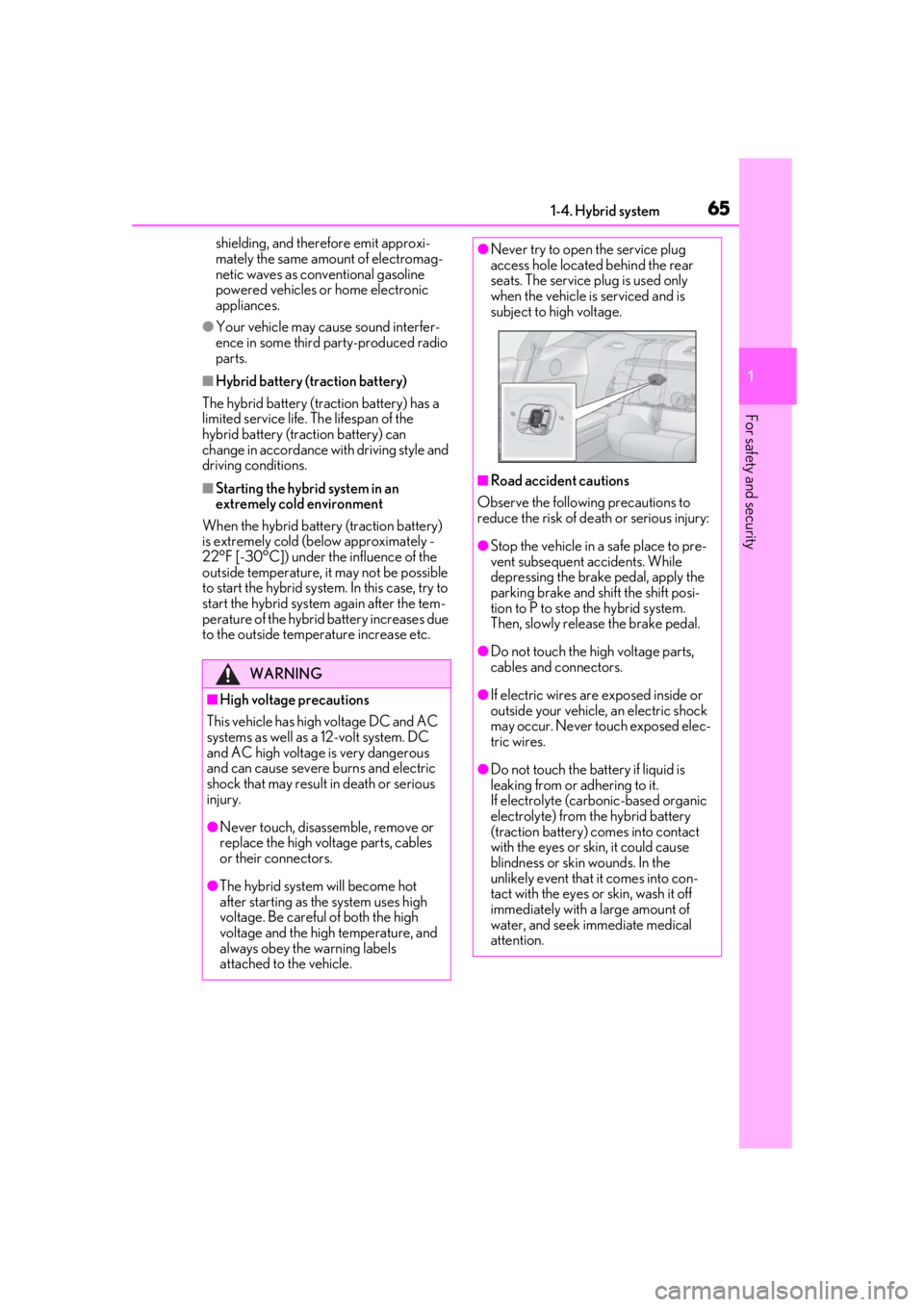
651-4. Hybrid system
1
For safety and security
shielding, and therefore emit approxi-
mately the same amount of electromag-
netic waves as conventional gasoline
powered vehicles or home electronic
appliances.
●Your vehicle may cause sound interfer-
ence in some third party-produced radio
parts.
■Hybrid battery (traction battery)
The hybrid battery (traction battery) has a
limited service life. The lifespan of the
hybrid battery (traction battery) can
change in accordance with driving style and
driving conditions.
■Starting the hybrid system in an
extremely cold environment
When the hybrid battery (traction battery)
is extremely cold (below approximately -
22°F [-30°C]) under the influence of the
outside temperature, it may not be possible
to start the hybrid system. In this case, try to
start the hybrid system again after the tem-
perature of the hybrid battery increases due
to the outside temperature increase etc.
WARNING
■High voltage precautions
This vehicle has high voltage DC and AC
systems as well as a 12-volt system. DC
and AC high voltage is very dangerous
and can cause severe burns and electric
shock that may result in death or serious
injury.
●Never touch, disassemble, remove or
replace the high voltage parts, cables
or their connectors.
●The hybrid system will become hot
after starting as the system uses high
voltage. Be careful of both the high
voltage and the high temperature, and
always obey the warning labels
attached to the vehicle.
●Never try to open the service plug
access hole located behind the rear
seats. The service pl ug is used only
when the vehicle is serviced and is
subject to high voltage.
■Road accident cautions
Observe the following precautions to
reduce the risk of de ath or serious injury:
●Stop the vehicle in a safe place to pre-
vent subsequent accidents. While
depressing the brake pedal, apply the
parking brake and sh ift the shift posi-
tion to P to stop the hybrid system.
Then, slowly release the brake pedal.
●Do not touch the high voltage parts,
cables and connectors.
●If electric wires ar e exposed inside or
outside your vehicle, an electric shock
may occur. Never touch exposed elec-
tric wires.
●Do not touch the battery if liquid is
leaking from or adhering to it.
If electrolyte (carbonic-based organic
electrolyte) from the hybrid battery
(traction battery) comes into contact
with the eyes or skin, it could cause
blindness or skin wounds. In the
unlikely event that it comes into con-
tact with the eyes or skin, wash it off
immediately with a large amount of
water, and seek immediate medical
attention.
Page 75 of 432
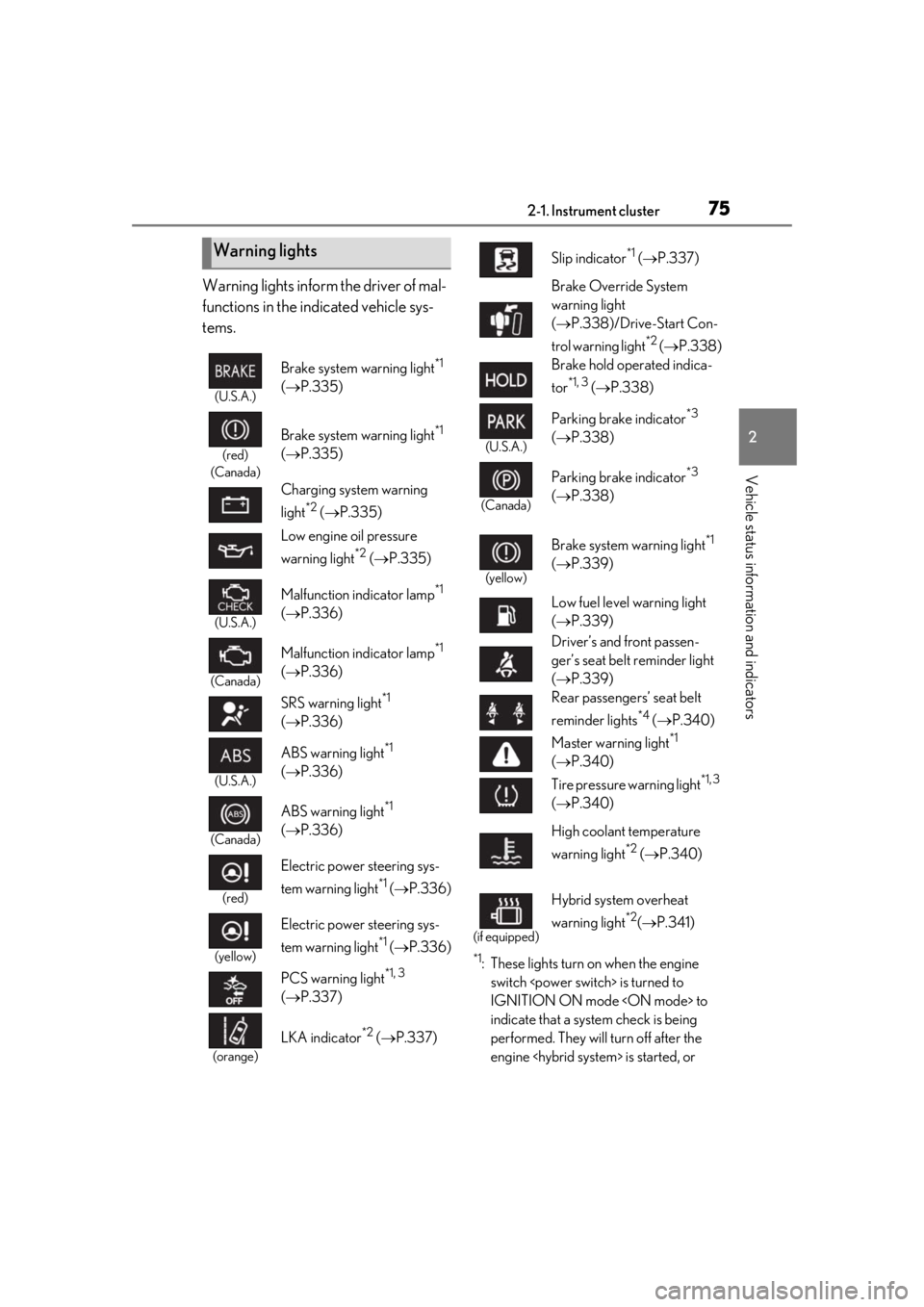
752-1. Instrument cluster
2
Vehicle status information and indicators
Warning lights inform the driver of mal-
functions in the indicated vehicle sys-
tems.
*1: These lights turn on when the engine switch
IGNITION ON mode
indicate that a system check is being
performed. They will turn off after the
engine
Warning lights
(U.S.A.)
Brake system warning light*1
( P.335)
(red)
(Canada)
Brake system warning light*1
( P.335)
Charging system warning
light
*2 ( P.335)
Low engine oil pressure
warning light
*2 ( P.335)
(U.S.A.)
Malfunction indicator lamp*1
( P.336)
(Canada)
Malfunction indicator lamp*1
( P.336)
SRS warning light
*1
( P.336)
(U.S.A.)
ABS warning light*1
( P.336)
(Canada)
ABS warning light*1
( P.336)
(red)
Electric power steering sys-
tem warning light
*1 ( P.336)
(yellow)
Electric power steering sys-
tem warning light
*1 ( P.336)
PCS warning light
*1, 3
( P.337)
(orange)
LKA indicator*2 ( P.337)
Slip indicator*1 ( P.337)
Brake Override System
warning light
( P.338)/Drive-Start Con-
trol warning light
*2 ( P.338)
Brake hold operated indica-
tor
*1, 3 ( P.338)
(U.S.A.)
Parking brake indicator*3
( P.338)
(Canada)
Parking brake indicator*3
( P.338)
(yellow)
Brake system warning light*1
( P.339)
Low fuel level warning light
( P.339)
Driver’s and front passen-
ger’s seat belt reminder light
( P.339)
Rear passengers’ seat belt
reminder lights
*4 ( P.340)
Master warning light
*1
( P.340)
Tire pressure warning light
*1, 3
( P.340)
High coolant temperature
warning light
*2 ( P.340)
(if equipped)
Hybrid system overheat
warning light
*2( P.341)
Page 76 of 432
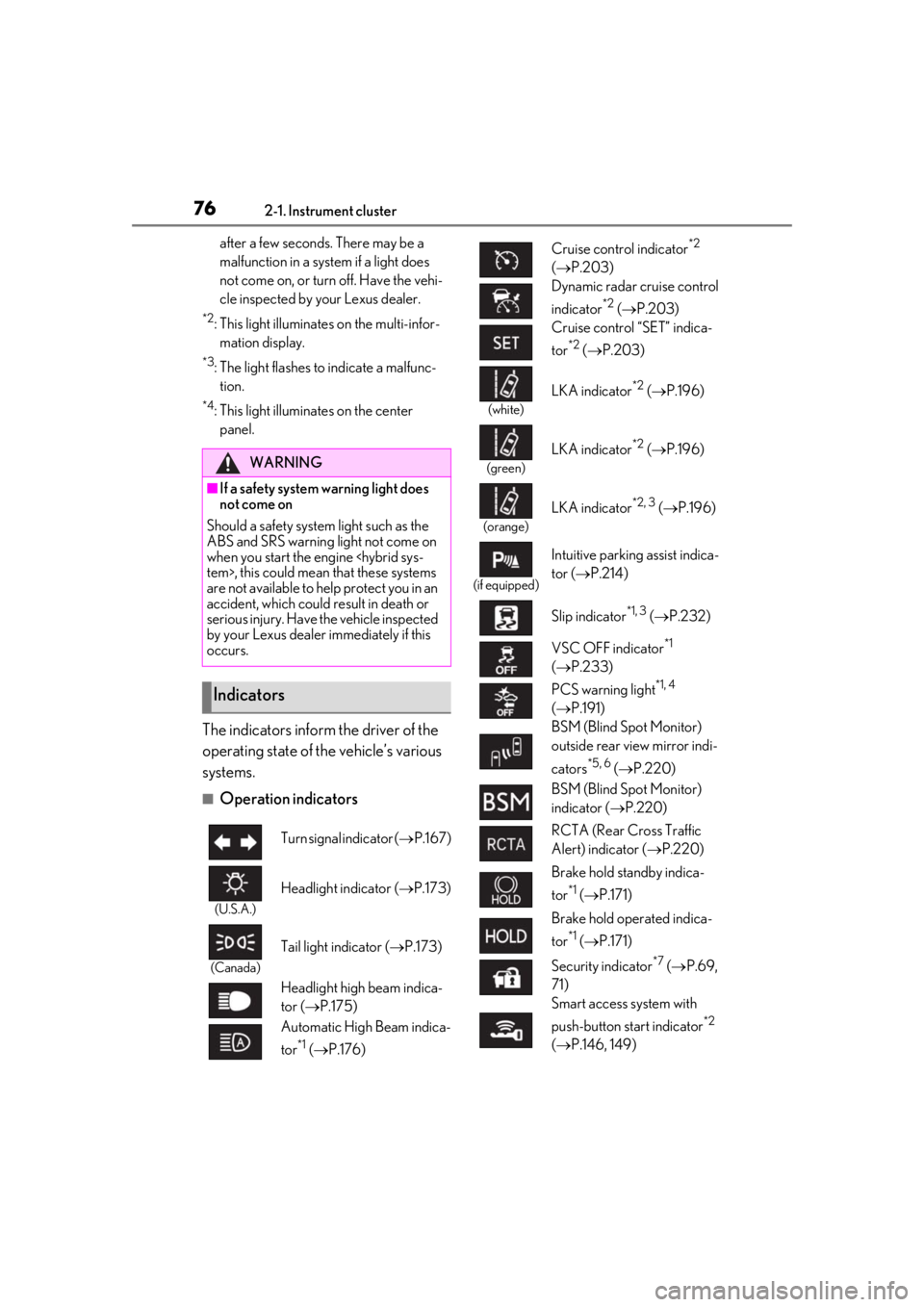
762-1. Instrument cluster
after a few seconds. There may be a
malfunction in a system if a light does
not come on, or turn off. Have the vehi-
cle inspected by your Lexus dealer.
*2: This light illuminates on the multi-infor-mation display.
*3: The light flashes to indicate a malfunc-tion.
*4: This light illuminates on the center panel.
The indicators inform the driver of the
operating state of the vehicle’s various
systems.
■Operation indicators
WARNING
■If a safety system warning light does
not come on
Should a safety system light such as the
ABS and SRS warning light not come on
when you start the engine
are not available to he lp protect you in an
accident, which could result in death or
serious injury. Have the vehicle inspected
by your Lexus dealer immediately if this
occurs.
Indicators
Turn signal indicator ( P.167)
(U.S.A.)
Headlight indicator ( P.173)
(Canada)
Tail light indicator ( P.173)
Headlight high beam indica-
tor ( P.175)
Automatic High Beam indica-
tor
*1 ( P.176)
Cruise control indicator*2
( P.203)
Dynamic radar cruise control
indicator
*2 ( P.203)
Cruise control “SET” indica-
tor
*2 ( P.203)
(white)
LKA indicator*2 ( P.196)
(green)
LKA indicator*2 ( P.196)
(orange)
LKA indicator*2, 3 ( P.196)
(if equipped)
Intuitive parking assist indica-
tor ( P.214)
Slip indicator
*1, 3 ( P.232)
VSC OFF indicator
*1
( P.233)
PCS warning light
*1, 4
( P.191)
BSM (Blind Spot Monitor)
outside rear view mirror indi-
cators
*5, 6 ( P.220)
BSM (Blind Spot Monitor)
indicator ( P.220)
RCTA (Rear Cross Traffic
Alert) indicator ( P.220)
Brake hold standby indica-
tor
*1 ( P.171)
Brake hold operated indica-
tor
*1 ( P.171)
Security indicator
*7 ( P.69,
71)
Smart access system with
push-button start indicator
*2
( P.146, 149)
Page 77 of 432
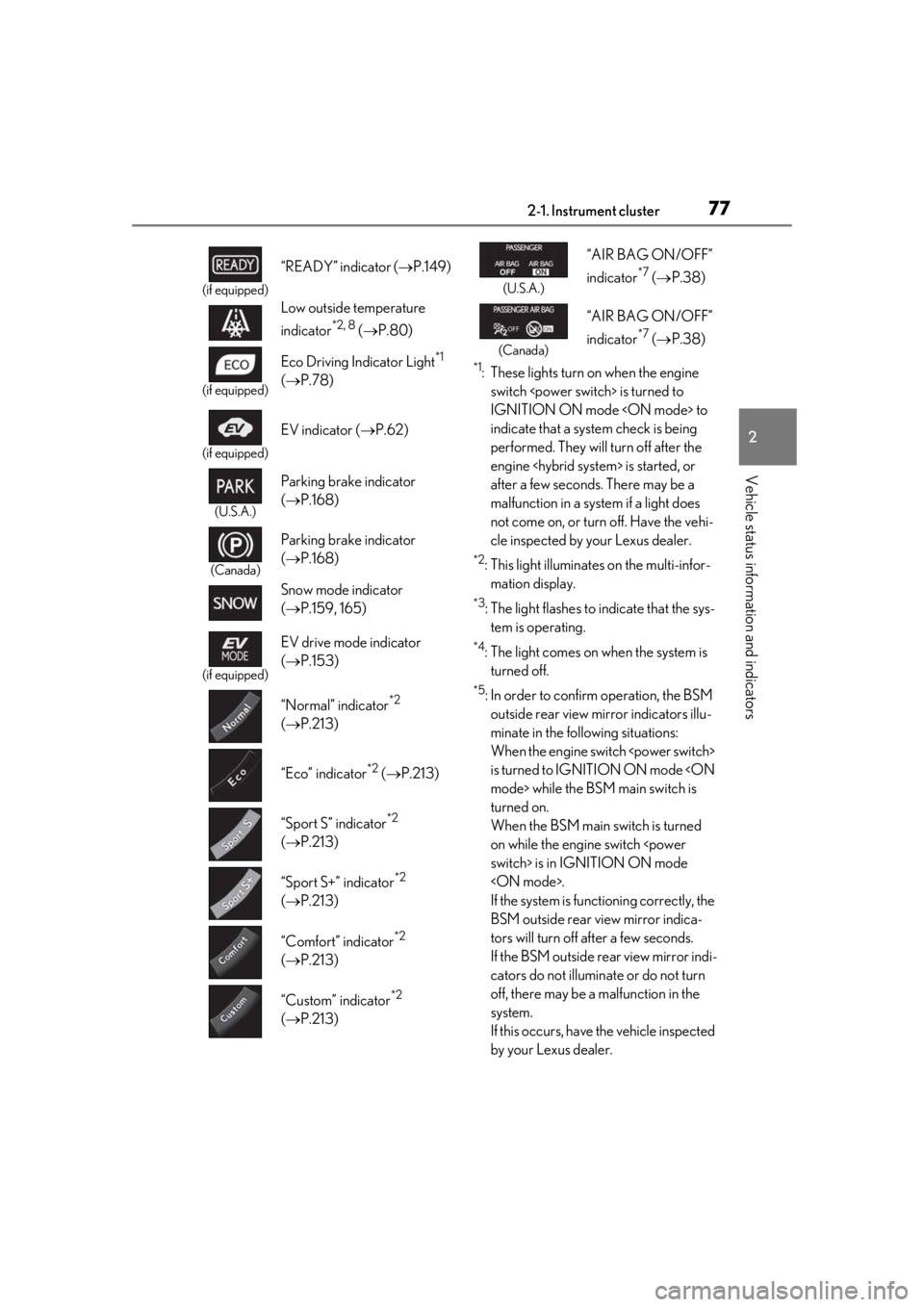
772-1. Instrument cluster
2
Vehicle status information and indicators
*1: These lights turn on when the engine switch
IGNITION ON mode
indicate that a system check is being
performed. They will turn off after the
engine
after a few seconds. There may be a
malfunction in a syst em if a light does
not come on, or turn off. Have the vehi-
cle inspected by your Lexus dealer.
*2: This light illuminates on the multi-infor- mation display.
*3: The light flashes to indicate that the sys-tem is operating.
*4: The light comes on when the system is turned off.
*5: In order to confirm operation, the BSM outside rear view mirror indicators illu-
minate in the following situations:
When the engine switch
is turned to IGNITION ON mode
turned on.
When the BSM main switch is turned
on while the engine switch
If the system is func tioning correctly, the
BSM outside rear view mirror indica-
tors will turn off after a few seconds.
If the BSM outside rear view mirror indi-
cators do not illuminate or do not turn
off, there may be a malfunction in the
system.
If this occurs, have the vehicle inspected
by your Lexus dealer.
(if equipped)
“READY” indicator ( P.149)
Low outside temperature
indicator
*2, 8 ( P.80)
(if equipped)
Eco Driving Indicator Light*1
( P.78)
(if equipped)
EV indicator ( P.62)
(U.S.A.)
Parking brake indicator
( P.168)
(Canada)
Parking brake indicator
( P.168)
Snow mode indicator
( P.159, 165)
(if equipped)
EV drive mode indicator
( P.153)
“Normal” indicator
*2
( P.213)
“Eco” indicator
*2 ( P.213)
“Sport S” indicator
*2
( P.213)
“Sport S+” indicator
*2
( P.213)
“Comfort” indicator
*2
( P.213)
“Custom” indicator
*2
( P.213)
(U.S.A.)
“AIR BAG ON/OFF”
indicator
*7 ( P.38)
(Canada)
“AIR BAG ON/OFF”
indicator
*7 ( P.38)
Page 135 of 432
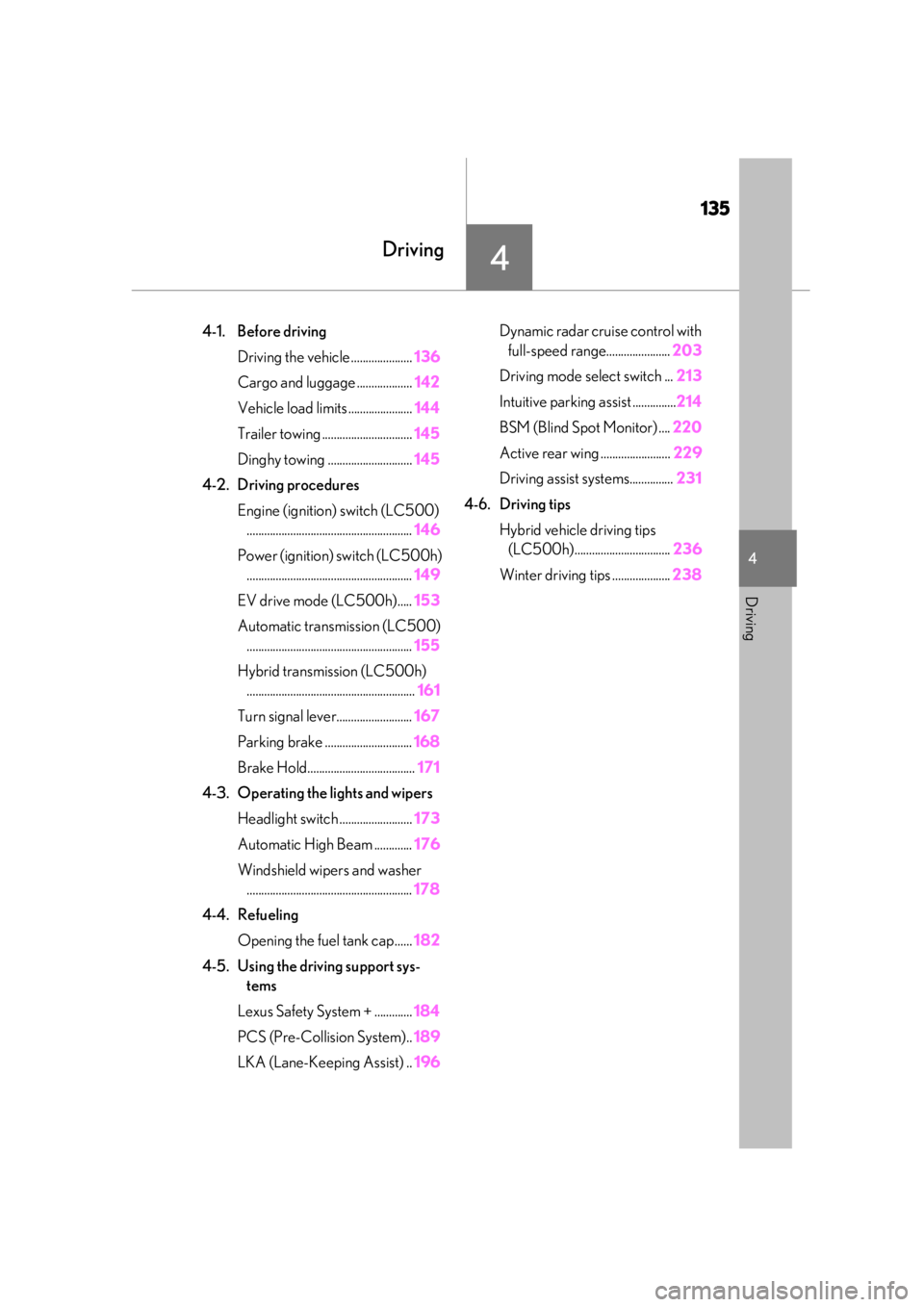
135
4
4
Driving
Driving
4-1. Before drivingDriving the vehicle ..................... 136
Cargo and luggage ................... 142
Vehicle load limits ...................... 144
Trailer towing ............................... 145
Dinghy towing ............................. 145
4-2. Driving procedures Engine (ignition) switch (LC500)......................................................... 146
Power (ignition) switch (LC500h) ......................................................... 149
EV drive mode (LC500h)..... 153
Automatic transmission (LC500) ......................................................... 155
Hybrid transmission (LC500h) .......................................................... 161
Turn signal lever.......................... 167
Parking brake .............................. 168
Brake Hold..................................... 171
4-3. Operating the lights and wipers Headlight switch ......................... 173
Automatic High Beam ............. 176
Windshield wipers and washer ......................................................... 178
4-4. Refueling Opening the fuel tank cap...... 182
4-5. Using the driving support sys- tems
Lexus Safety System + ............. 184
PCS (Pre-Collision System).. 189
LKA (Lane-Keeping Assist) .. 196Dynamic radar cruise control with
full-speed range...................... 203
Driving mode select switch ... 213
Intuitive parking assist ............... 214
BSM (Blind Spot Monitor) .... 220
Active rear wing ........................ 229
Driving assist systems............... 231
4-6. Driving tips Hybrid vehicle driving tips (LC500h)................................. 236
Winter driving tips .................... 238
Page 136 of 432
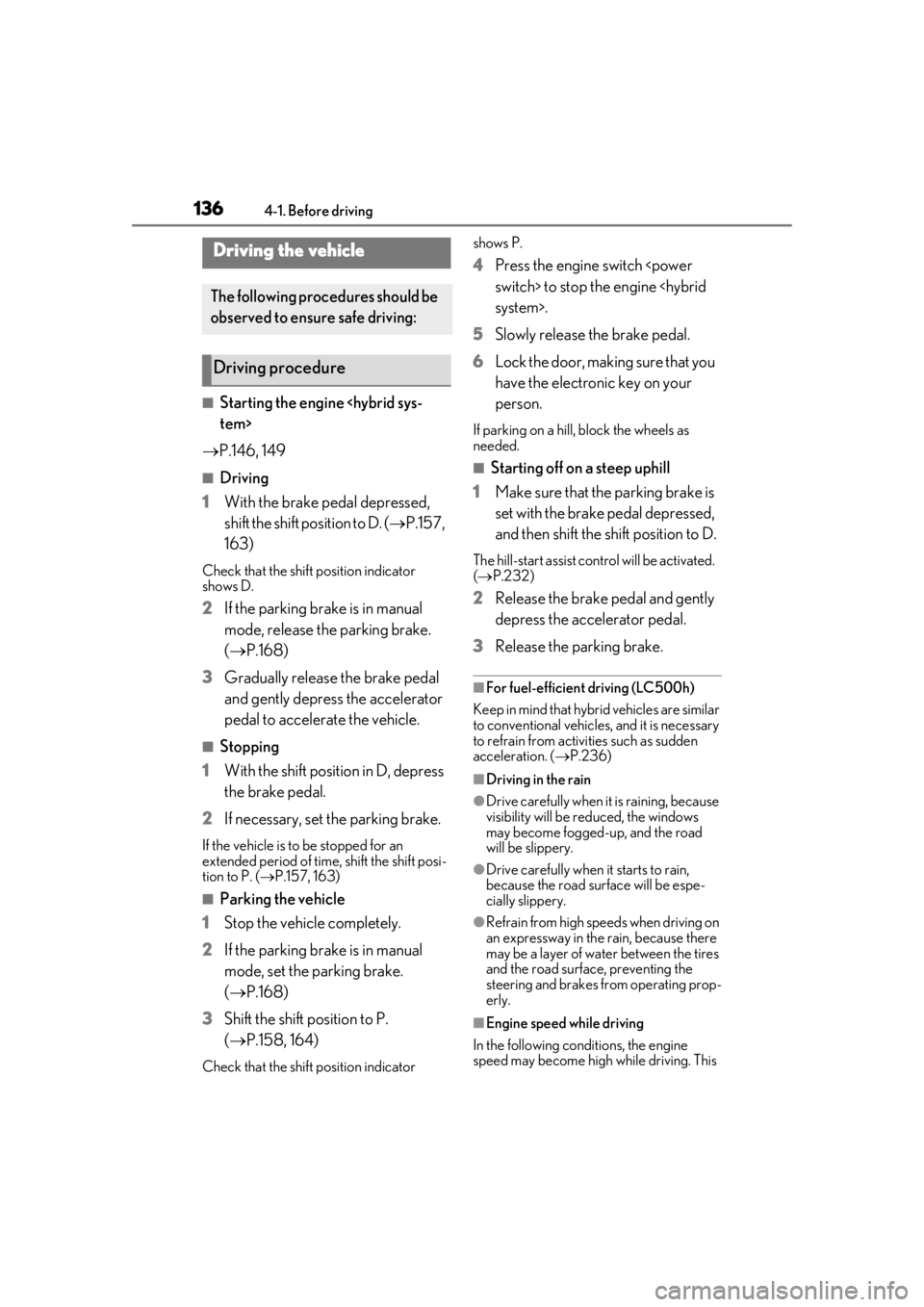
1364-1. Before driving
4-1.Before driving
■Starting the engine
P.146, 149
■Driving
1 With the brake pedal depressed,
shift the shift position to D. ( P.157,
163)
Check that the shift position indicator
shows D.
2 If the parking brake is in manual
mode, release the parking brake.
(P.168)
3 Gradually release the brake pedal
and gently depress the accelerator
pedal to accelerate the vehicle.
■Stopping
1 With the shift position in D, depress
the brake pedal.
2 If necessary, set the parking brake.
If the vehicle is to be stopped for an
extended period of time, shift the shift posi-
tion to P. ( P.157, 163)
■Parking the vehicle
1 Stop the vehicle completely.
2 If the parking brake is in manual
mode, set the parking brake.
(P.168)
3 Shift the shift position to P.
(P.158, 164)
Check that the shift position indicator shows P.
4
Press the engine switch
5 Slowly release the brake pedal.
6 Lock the door, making sure that you
have the electronic key on your
person.
If parking on a hill, block the wheels as
needed.
■Starting off on a steep uphill
1 Make sure that the parking brake is
set with the brake pedal depressed,
and then shift the shift position to D.
The hill-start assist control will be activated.
( P.232)
2 Release the brake pedal and gently
depress the accelerator pedal.
3 Release the parking brake.
■For fuel-efficient driving (LC500h)
Keep in mind that hybr id vehicles are similar
to conventional vehicles, and it is necessary
to refrain from activi ties such as sudden
acceleration. ( P.236)
■Driving in the rain
●Drive carefully when it is raining, because
visibility will be reduced, the windows
may become fogged-up, and the road
will be slippery.
●Drive carefully when it starts to rain,
because the road surface will be espe-
cially slippery.
●Refrain from high speeds when driving on
an expressway in the rain, because there
may be a layer of wa ter between the tires
and the road surface, preventing the
steering and brakes from operating prop-
erly.
■Engine speed while driving
In the following conditions, the engine
speed may become high while driving. This
Driving the vehicle
The following procedures should be
observed to ensure safe driving:
Driving procedure
Page 137 of 432
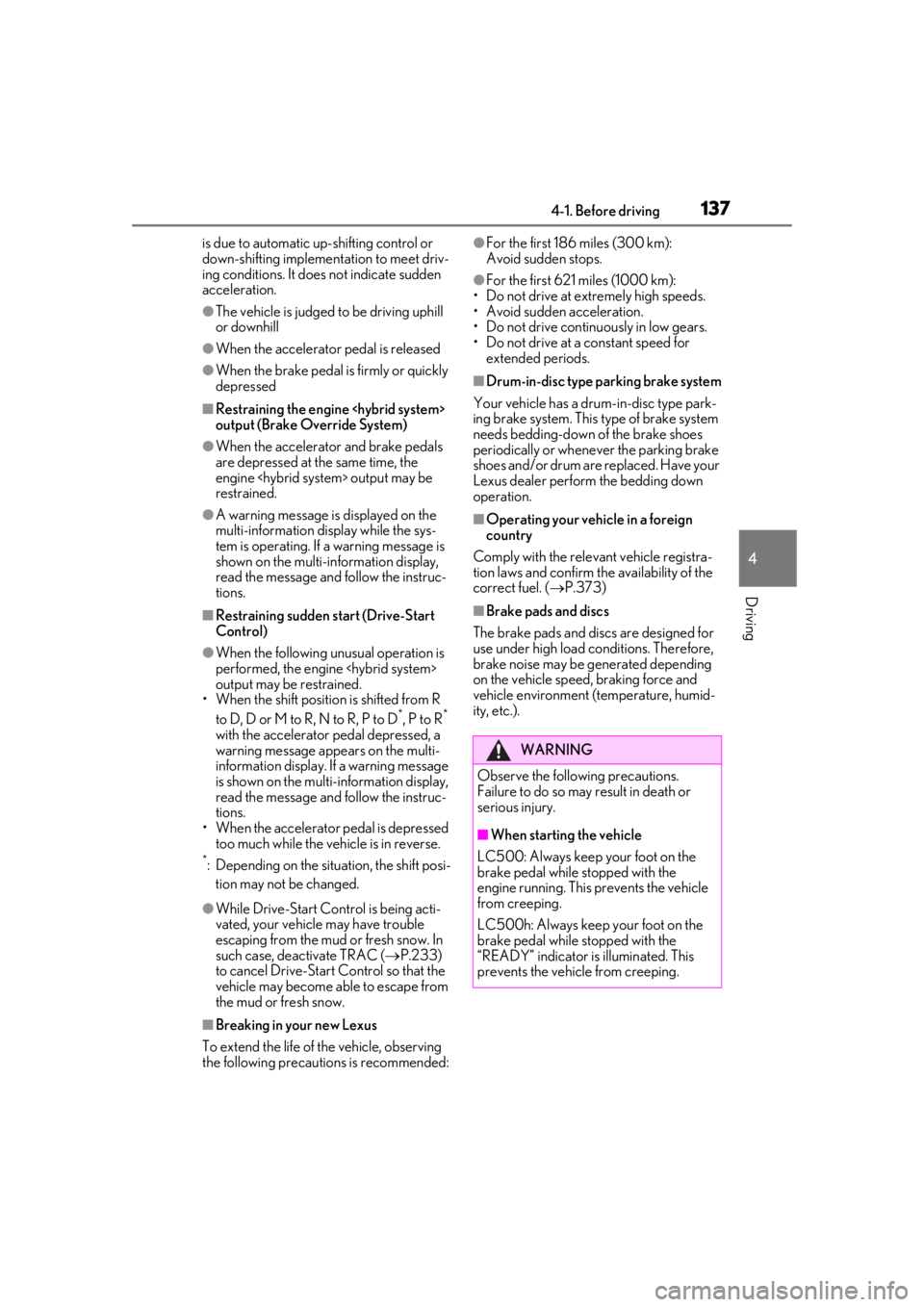
1374-1. Before driving
4
Driving
is due to automatic up-shifting control or
down-shifting implementation to meet driv-
ing conditions. It does not indicate sudden
acceleration.
●The vehicle is judged to be driving uphill
or downhill
●When the accelerator pedal is released
●When the brake pedal is firmly or quickly
depressed
■Restraining the engine
output (Brake Override System)
●When the accelerator and brake pedals
are depressed at the same time, the
engine
restrained.
●A warning message is displayed on the
multi-information display while the sys-
tem is operating. If a warning message is
shown on the multi-information display,
read the message and follow the instruc-
tions.
■Restraining sudden start (Drive-Start
Control)
●When the following unusual operation is
performed, the engine
output may be restrained.
• When the shift position is shifted from R
to D, D or M to R, N to R, P to D
*, P to R*
with the accelerator pedal depressed, a
warning message appears on the multi-
information display. If a warning message
is shown on the multi-information display,
read the message and follow the instruc-
tions.
• When the accelerator pedal is depressed
too much while the vehicle is in reverse.
*: Depending on the situation, the shift posi-
tion may not be changed.
●While Drive-Start Control is being acti-
vated, your vehicle may have trouble
escaping from the mud or fresh snow. In
such case, deactivate TRAC ( P.233)
to cancel Drive-Start Control so that the
vehicle may become able to escape from
the mud or fresh snow.
■Breaking in your new Lexus
To extend the life of the vehicle, observing
the following precautions is recommended:
●For the first 186 miles (300 km):
Avoid sudden stops.
●For the first 621 miles (1000 km):
• Do not drive at extremely high speeds.
• Avoid sudden acceleration.
• Do not drive continuously in low gears.
• Do not drive at a constant speed for extended periods.
■Drum-in-disc type parking brake system
Your vehicle has a drum-in-disc type park-
ing brake system. This type of brake system
needs bedding-down of the brake shoes
periodically or whenever the parking brake
shoes and/or drum are replaced. Have your
Lexus dealer perform the bedding down
operation.
■Operating your vehicle in a foreign
country
Comply with the relevant vehicle registra-
tion laws and confirm the availability of the
correct fuel. ( P.373)
■Brake pads and discs
The brake pads and discs are designed for
use under high load conditions. Therefore,
brake noise may be generated depending
on the vehicle speed, braking force and
vehicle environment (temperature, humid-
ity, etc.).
WARNING
Observe the following precautions.
Failure to do so may result in death or
serious injury.
■When starting the vehicle
LC500: Always keep your foot on the
brake pedal while stopped with the
engine running. This prevents the vehicle
from creeping.
LC500h: Always keep your foot on the
brake pedal while stopped with the
“READY” indicator is illuminated. This
prevents the vehicle from creeping.
Page 138 of 432
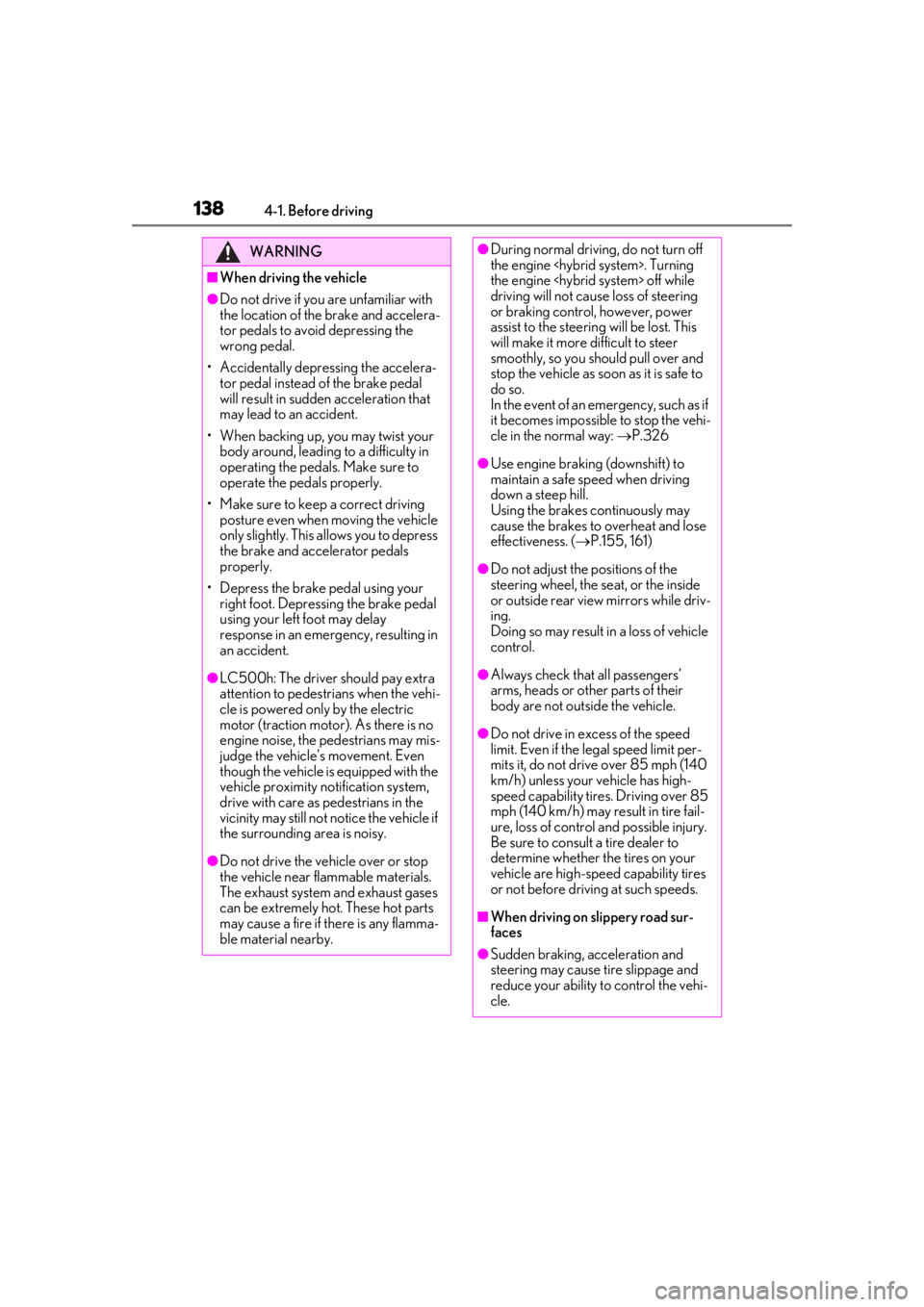
1384-1. Before driving
WARNING
■When driving the vehicle
●Do not drive if you are unfamiliar with
the location of the brake and accelera-
tor pedals to avoid depressing the
wrong pedal.
• Accidentally depressing the accelera- tor pedal instead of the brake pedal
will result in sudden acceleration that
may lead to an accident.
• When backing up, you may twist your body around, leading to a difficulty in
operating the pedals. Make sure to
operate the pedals properly.
• Make sure to keep a correct driving posture even when moving the vehicle
only slightly. This allows you to depress
the brake and accelerator pedals
properly.
• Depress the brake pedal using your right foot. Depressing the brake pedal
using your left foot may delay
response in an emergency, resulting in
an accident.
●LC500h: The driver should pay extra
attention to pedestrians when the vehi-
cle is powered only by the electric
motor (traction motor). As there is no
engine noise, the pedestrians may mis-
judge the vehicle’s movement. Even
though the vehicle is equipped with the
vehicle proximity notification system,
drive with care as pedestrians in the
vicinity may still not notice the vehicle if
the surrounding area is noisy.
●Do not drive the vehicle over or stop
the vehicle near flammable materials.
The exhaust system and exhaust gases
can be extremely hot. These hot parts
may cause a fire if there is any flamma-
ble material nearby.
●During normal driving, do not turn off
the engine
the engine
driving will not cause loss of steering
or braking control, however, power
assist to the steering will be lost. This
will make it more difficult to steer
smoothly, so you should pull over and
stop the vehicle as soon as it is safe to
do so.
In the event of an emergency, such as if
it becomes impossible to stop the vehi-
cle in the normal way: P.326
●Use engine braking (downshift) to
maintain a safe speed when driving
down a steep hill.
Using the brakes continuously may
cause the brakes to overheat and lose
effectiveness. ( P.155, 161)
●Do not adjust the positions of the
steering wheel, the seat, or the inside
or outside rear view mirrors while driv-
ing.
Doing so may result in a loss of vehicle
control.
●Always check that all passengers’
arms, heads or other parts of their
body are not outside the vehicle.
●Do not drive in excess of the speed
limit. Even if the legal speed limit per-
mits it, do not drive over 85 mph (140
km/h) unless your vehicle has high-
speed capability tires. Driving over 85
mph (140 km/h) may re sult in tire fail-
ure, loss of control and possible injury.
Be sure to consult a tire dealer to
determine whether the tires on your
vehicle are high-speed capability tires
or not before driving at such speeds.
■When driving on slippery road sur-
faces
●Sudden braking, acceleration and
steering may cause tire slippage and
reduce your ability to control the vehi-
cle.